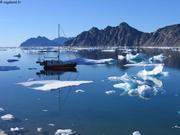Ice pack, little auks and cretaceous, by France Pinczon du Sel and Eric Brossier:
20 September 2005. Vagabond is now back to Longyearbyen, after a summer on the East coast of Greenland, as a logistical base for 2 scientific projects. Almost back 'home', as on 13th July only, after over 9 months frozen in ice on the East coast of Spitsbergen, Vagabond finally found her way out of the ice and sailed across the Greenland sea, to Ittoqqortoormiit. Not far from this small village, at the entrance of the very large Scoresby Sund fjord, a very international birdwatching crew was waiting for her.
Then we started to understand more about these fascinating little auks breeding in steep slopes and flying far off shore, above the ice pack, to get food for their chicks. While Ann, from Alaska, Maguy, from Ireland, and David, from France, were studying birds at Kap Hoegh colony, we sailed Vagabond through the ice pack, heavier than the past 6 years, to allow Heli, from Finland, and Jozef, from Poland, to use the CTD and the plankton net every few miles, without stopping counting birds. Great ice atmosphere, fog patches, sometimes sailing, sometimes drifting when too much ice. Here a female polar bear with her 2 cubs eating a seal... 500 miles total, 25 plankton samples, 36 CTD casts, job has been done successfully.
The second project brought us further north, in the National Park. The French geology crew was first welcomed by the tail of a hurricane. 45 knots of wind pushing Vagabond to fight against the waves, also moving away all drifting ice for the next 3 weeks of the expedition. What a change with the previous weeks! Between Kong Oscar Fjord and Kejser Franz Joseph Fjord, where are many large and long fjords, we sailed with the geologists with a constant sunny weather. After 17 stops and many walking hours, Vagabond was loaded with more than 150 kg of rock samples that will be studied in France. There was also muskox, northern lights, and a nice time with 2 members of the Sirius patrol, going all around north Greenland every winter with dog teams.
7 days sailing with a small crew, with a better weather than expected at this time of the year, took us back to Spitsbergen. We already spent almost a year here, Vagabond is going to stay 3 or 4 years more. Damocles, a big European project about arctic oceanography, part of the International Polar Year program, will use Vagabond. Again frozen in ice on the East coast of Spitsbergen, the polar yacht will be a base camp for testing new equipments before sending it in various places in the Arctic Ocean. CTD casts and weather observations will carry on all year round. We are also happy to use our experience from the first winter, to keep on living in the Arctic, winter and summer. About 4 dogs will join us this time, to better move around and watch for polar bears. We saw almost 90 of them last winter !
This long project will allow us to share our time between Spitsbergen and France, thanks to some crew that will take over for some weeks. Time to meet our families, friends and partners... getting more energy to keep on moving ahead.
Presentation of ADACLIM program, little auk study, by David Grémillet and Ann Harding:
A clearer understanding of how Arctic marine ecosystems will react to climate change is important. In order to detect and predict ecological responses to environmental change in these fragile marine systems we are studying the Little Auk (Alle alle), an Arctic seabird that has a specialized zooplankton diet. We are comparing the breeding and feeding ecology of populations of Little Auks foraging in the cold Arctic water off the east coast of Greenland with populations foraging in water dominated by warmer, Atlantic water off west Spitsbergen. These comparisons provide a unique opportunity to study populations of Arctic marine predators in highly contrasting oceanographic conditions, and assess their flexibility to environmental constraints. The comparison of Little Auk populations breeding in these two contrasting oceanographic conditions requires simultaneous study. Two international projects (the MariClim project and Pomona College) will be conducted on the west coast of Spitsbergen from 2005-2008. Our aim is to collaborate closely with these two projects, lead all field work in east Greenland, and use information gathered from both regions to model the response of Little Auk populations to potential change in the arctic environment associated with climate change. In 2005 we will (1) Quantify differences in local oceanographic conditions between the two study sites (eastern and western Greenland Sea). (2) Determine the trophic status of the two Little Auk populations. (3) Compare the predatory efficiencies of the two populations. (4) Examine the breeding strategies and adult survival of Little Auks. These trials will be a first step towards a better understanding of how Arctic marine predators react to climate change.
Presentation of MARVOL program, by Laurent Geoffroy :
The eastern coast of Greenland is a volcanic passive margin, area of particular scientific interest for a decade. This well exposed volcanic margin has an equivalent (Voring basin) but located offshore (W of Norway). It is then important to have access to the outcrops well exposed in perpendicular-disposed fjords. In addition, our area of investigation is located above a thermal anomaly which origin is disputed.
There are two main goals for this research project :
- Understanding the deformation pattern of the NE Greenland margin. To that purpose, field study is necessary to have the catalog of fractures, faults, and tilt of sedimentary units.
- Sampling rocks (Mesozoic sedimentary rocks and Tertiary volcanics). These rocks will be submitted to numerous analyses including thermal signatures and dating.

